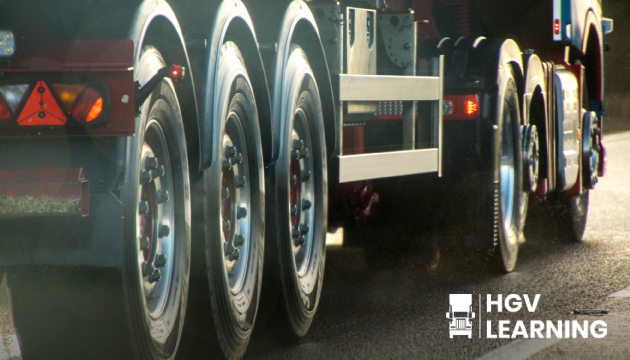Related Articles

28/10/2025
Preventing HGV Overloading: Legal Limits and On-the-Road Consequences

21/10/2025

Effective HGV tyre management plays a vital role in ensuring both safety and efficiency. Tyres are the only part of the vehicle in contact with the road, so their condition directly affects braking, handling, and fuel consumption. For HGV operators, poor tyre maintenance isn’t just dangerous, it also leads to fines, downtime, and higher operating costs.
This guide offers practical ways to maintain and manage HGV tyres for long life and full compliance with UK regulations as of 2025.
The legal minimum tread depth for HGV tyres in the UK is 1mm across a continuous band in the central three-quarters of the tread. While this is the legal limit, many fleet operators choose to replace tyres once they reach 2mm or 3mm to maintain optimal performance, especially in wet or winter conditions. This is considered a best practice for safety, not a legal requirement.
Tyres must be free from cuts, bulges, exposed cords or objects embedded in the tread. Excessive wear or damage can lead to DVSA enforcement action during roadside checks.
Since February 2021, UK regulations have prohibited the use of tyres aged more than 10 years on the front (steering) axles of HGVs and on any single-wheel axles of minibuses. Operators must check the tyre’s DOT code on the sidewall to confirm age.
On other axles, tyres over 10 years old may still be used if the operator has a documented risk assessment, tyre management policy, and can prove the tyres remain roadworthy. However, most fleets choose to replace tyres before they reach this threshold.
For up-to-date safety guidelines, consult our driver advice hub.

Drivers should carry out a walk-around check each day. This includes examining tyres for visible damage, bulges, embedded objects, or uneven wear. Uneven tread often points to incorrect tyre pressure or axle misalignment.
For a full checklist, visit our guide on HGV safety tips.
Maintaining correct tyre pressure improves handling, load balance and fuel efficiency. Incorrect pressure affects braking and cornering. Drivers should check pressure weekly using a calibrated gauge and adjust it according to the manufacturer’s load specs.
In addition, check the pressure before long journeys or major changes in load type. Seasonal temperature shifts can also affect tyre pressure and should prompt a recheck.
Each tyre has a specific load capacity. Exceeding this limit creates heat buildup and raises the risk of tyre failure. Always observe axle weight limits and spread loads evenly.
To learn more about balanced loading, read our post on HGV load distribution.
Under-inflated tyres flex too much, which causes heat buildup. This heat weakens the tyre from within and increases wear. Tyres running at low pressure are a major cause of roadside breakdowns.
Nails, sharp debris or glass can puncture tyres. During daily checks, drivers should remove foreign objects from the tread. Any sidewall bulge or deep cut could mean serious structural damage. A professional inspection or replacement is the safest option.
Internal damage, especially after a severe impact, may not always be visible externally. When in doubt, a tyre should be removed and inspected or replaced.
Rotating tyres between axles and wheel positions helps them wear more evenly. A tyre rotation schedule should suit the vehicle type, usage, and weight distribution.
Technicians should carry out the rotations and log them properly. Incorrect rotation patterns can create wear issues or safety concerns.
Replace tyres when they:
Fleet operators may also regroove tyres as part of their tyre life extension strategy, but only when permitted by the manufacturer. Improper regrooving or exceeding legal regroove depth may make the tyre unsafe or illegal.
Tyres vary depending on the type of operation. For example, regional, long-haul and mixed-service tyres differ in grip, wear rate, and fuel use. Selecting the right type ensures the vehicle performs as expected.
Speak to tyre suppliers about options for your routes and loads. Not every tyre balances grip and longevity in the same way.
Low rolling resistance tyres cut fuel use over long distances. Though more expensive up front, they offer savings across the tyre’s life.
For tips on fuel-saving driving habits, see our guide on CPC driver training and eco-driving.
Fleet operators often use digital systems to monitor tyre pressure, heat and wear. These systems send alerts before failures happen, which helps avoid breakdowns.
Advanced TMS tools can also log mileage and maintenance dates. This makes budgeting for replacements easier and reduces unplanned costs.
Every fleet should keep clear records of tyre checks and replacements. Whether digital or written, these logs support compliance. They’re useful for audits, roadside stops and improving accountability.
Make sure records stay updated and easily available to drivers and inspectors.
Drivers must understand tyre care basics. Training should cover pressure checks, tread wear, and reporting procedures. Toolbox talks and refresher sessions reinforce good habits.
Include tyre awareness in driver performance reviews. A proactive approach leads to fewer failures and safer journeys.
A good tyre policy includes inspection routines, supplier standards, and reporting systems. Equip drivers with pressure gauges and encourage open communication about defects.
Building a partnership with a tyre service provider adds roadside support and emergency coverage. This improves fleet resilience and minimises downtime.
Looking after HGV tyres goes beyond legal compliance. It improves safety, cuts operating costs and extends tyre life. When drivers perform regular checks and fleets invest in proper systems, everyone benefits.
As of 2025, regulations remain focused on tyre age, maintenance records, and visible signs of damage or wear. There are also ongoing industry discussions about raising the minimum legal tread depth for added safety. Fleet managers should stay informed of any updates from DVSA or government reviews.
For more advice on driver safety and maintenance, visit the HGV Learning Knowledge Hub.

28/10/2025

21/10/2025
Complete the form below and we’ll contact you asap.

